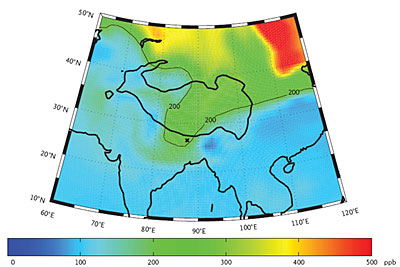 HIGH POLLUTION: The green area denotes ozone-rich air migrating from industries in the neighbourhood in 2007. The thick black line encircles the Tibetan plateau and X indicates Mount Everest. |
Amazingly, pollution-related ozone concentrations in the Mount Everest region are reported to be very high as shown by John Semple, colleagues from the University of Toronto in a 2009 March issue of the New England Medical Journal. This is potentially alarming because death rates from respiratory causes are associated with increasing concentrations of ozone. The Mount Everest region is somewhere you can inhale deeply without feeling a burning throat sensation as you do when you complete such a manoeuvre in Kathmandu. But if the ozone story is true, our lungs may be in for a rough ride even in the pristine Solukhumbu Valley.
Ozone concentrations in the troposphere have doubled globally since preindustrial times. They are now 30 ppb from estimates of 15 ppb in the pre-industrial era. And, not surprisingly, the major reason for this is burning of fossil fuel. (Not to be confused with the stratospheric ozone layer which is "good" ozone and protects the planet from harmful ultraviolet rays from the sun.)
This is potentially a "double whammy' situation for the villages in Solu Khumbu region. Researchers have long known the risks of indoor stoves without chimneys that are used in Nepali villages. The risks are pneumonia in children, chronic lung and heart diseases in adults, and even lung cancer. Many people suffer from these illnesses and die young. Clean burning stoves with functioning chimneys, and social acceptance of these kitchen changes would go a long way in addressing this neglected area of public health in Nepal.
If more studies on ozone levels in Solukhumbu confirm the findings that Semple and colleague have clearly demonstrated, our government will need to bring this matter up in world fora so that people can at least begin to think what the practical solutions may be.
But in the meantime, replacement of old stoves by clean burning ones is something that is an eminently "doable" project that will save thousands of lives even as we tackle the potentially more complicated problem of trans-boundary ozone pollution in the Himalaya.


